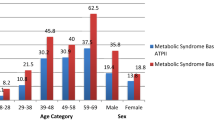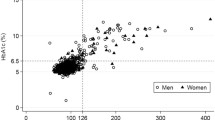Abstract
Background
Is there a difference in the prevalence of metabolic syndrome between employee service jobs and industrial jobs in Iran? In this study, we tried to answer this question. For this purpose, we compared the two populations of employees and workers. We compared the staff of the University of Medical Sciences as a service employees population (clinical and office work) to the industrial workers of a large automotive company (often with industrial occupations).
Method
In this cross-sectional study conducted in Tehran in 2020, the prevalence of metabolic syndrome among 4,372 people employed by the university and 3,899 automotive industry employees was examined and compared. The prevalence of metabolic syndrome was assessed based on two criteria, National Cholesterol Education Program Adult Treatment Panel III (ATP III) and International Diabetes Federation (IDF).
Results
The results showed that the prevalence of metabolic syndrome among university staff was higher than the automotive industrial workers. According to ATP III criteria, the former and latter showed the prevalence of metabolic syndrome of 13.1% among and 6.1%, respectively among. Also, based on IDF criteria, the prevalence of metabolic syndrome was 23.3% and 12.6% in two groups mentioned.
Conclusion
Based on the findings of this study, the prevalence of metabolic syndrome in university staff was almost double that in industry workers. At first glance, the physical activity of most automotive, industrial workers seems to be the main reason for this difference; however, a prevalence of about twice implies further factors. According to the authors, the legal implementation of monitoring, promotion, and surveillance programs of occupational health, in industrial environments can be a factor accounting for a significant difference in the prevalence of metabolic syndrome between the two populations observed. The authors suggest implementing similar programs for Iranian public sector employees to enhance their health status.
Similar content being viewed by others
References
Bonora E, DeFronzo RA. Diabetes complications, comorbidities, and related disorders: Springer; 2018.
O’Neill S, O’Driscoll L. Metabolic syndrome: a closer look at the growing epidemic and its associated pathologies. Obes Rev. 2015;16(1):1–12.
Nilsson PM, Tuomilehto J, Rydén L. The metabolic syndrome–What is it, and how should it be managed? Eur J Prev Cardiol. 2019;26(2_suppl):33–46.
Ansarimoghaddam A, Adineh HA, Zareban I, Iranpour S, HosseinZadeh A, Kh F. Prevalence of metabolic syndrome in Middle-East countries: Meta-analysis of cross-sectional studies. Diabetes Metab Syndr. 2018;12(2):195–201.
Dalvand S, Bakhshi E, Zarei M, Asl MT, Gheshlagh RG. Prevalence of Metabolic Syndrome in Iran: A systematic review and meta-analysis. Medical-Surgical Nursing Journal. 2017;5(4).
Nikbakht H-A, Rezaianzadeh A, Seif M, Ghaem H. Prevalence of metabolic syndrome and its components among a population-based study in south of Iran, PERSIAN Kharameh cohort study. Clin Epidemiol Glob Health. 2020;8(3):678–83.
Farmanfarma KK, Kaykhaei MA, Adineh HA, Mohammadi M, Dabiri S, Ansari-Moghaddam A. Prevalence of metabolic syndrome in Iran: A meta-analysis of 69 studies. Diabetes Metab Syndr. 2019;13(1):792–9.
Dalvand S, Niksima SH, Meshkani R, Gheshlagh RG, Sadegh-Nejadi S, Kooti W, et al. Prevalence of metabolic syndrome among Iranian population: a systematic review and meta-analysis. Iran J Public Health. 2017;46(4):456.
Chowdhury R, Shah D, Payal AR. Healthy worker effect phenomenon: revisited with emphasis on statistical methods–a review. Indian J Occup Environ Med. 2017;21(1):2.
Yu J. Relationship between long working hours and metabolic syndrome among Korean workers. Asian Nurs Res. 2017;11(1):36–41.
Tsai T-Y, Cheng J-F, Lai Y-M. Prevalence of metabolic syndrome and related factors in Taiwanese high-tech industry workers. Clinics. 2011;66(9):1531–5.
Alegría E, Cordero A, Laclaustra M, Grima A, León M, Casasnovas JA, et al. Prevalence of metabolic syndrome in the Spanish working population: MESYAS registry. Rev Esp Cardiol (Engl Ed). 2005;58(7):797–806.
Schultz AB, Edington DW. Metabolic syndrome in a workplace: prevalence, co-morbidities, and economic impact. Metab Syndr Relat Disord. 2009;7(5):459–68.
Niazi E, Saraei M, Aminian O, Izadi N. Frequency of metabolic syndrome and its associated factors in health care workers. Diabetes Metab Syndr. 2019;13(1):338–42.
Payab M, Hasani-Ranjbar S, Merati Y, Esteghamati A, Qorbani M, Hematabadi M, et al. The prevalence of metabolic syndrome and different obesity phenotypes in Iranian male military personnel. Am J Mens Health. 2017;11(2):404–13.
Mehrdad R, Pouryaghoub G, Moradi M. Association between metabolic syndrome and job rank. Int J Occup Environ Med. 2018;9(1):45.
Alavi S, Makarem J, Mehrdad R, Abbasi M. Metabolic syndrome: a common problem among office workers. Int J Occup Environ Med. 2015;6(1):34.
Bayraktarli RY, im Işsever H, Ulaş T, Erelel M, i Eser A, Özder A. Metabolic syndrome in collection and disposal of solid waste sector. Int J Occup Med Environ Health. 2012;25(1):14–21.
Nedjat S, Mehrdad R, Yunesian M, Pouragha H, Biagi V, Monazzam-Esmaeelpour MR. A prospective cohort study on the social determinants of health: Tehran University of Medical Sciences employee cohort (TEC) study protocol. BMC Public Health. 2020;20(1):1–7.
Pouragha H, Amiri M, Saraei M, Pouryaghoub G, Mehrdad R. Body impedance analyzer and anthropometric indicators; predictors of metabolic syndrome. J Diabetes Metab Disord. 2021;20(2):1169–78.
RA M. Henry’s Clinical Diagnosis and Management by Laboratory Methods: First South Asia Edition_e-Book. Elsevier India. 2017;1(23):606.
Petrie J, O’brien E, Littler W, De Swiet M. Recommendations on blood pressure measurement. Br Med J (Clin Res Ed). 1986;293(6547):611.
Organization WH. Waist circumference and waist-hip ratio: report of a WHO expert consultation, Geneva, 8-11 December 2008. 2011.
Expert Panel on Detection E. Executive summary of the third report of the National Cholesterol Education Program (NCEP) expert panel on detection, evaluation, and treatment of high blood cholesterol in adults (adult treatment panel III). JAMA. 2001;285(19):2486–97.
Alberti KGMM, Zimmet P, Shaw J. Metabolic syndrome—a new worldwide definition. A consensus statement from the international diabetes federation. Diabet Med. 2006;23(5):469–80.
Myong J-P, Kim H-R, Jung-Choi K, Baker D, Choi B. Disparities of metabolic syndrome prevalence by age, gender and occupation among Korean adult workers. Ind Health. 2012;50(2):115–22.
Sánchez-Chaparro M-A, Calvo-Bonacho E, González-Quintela A, Fernández-Labandera C, Cabrera M, Sáinz J-C, et al. Occupation-related differences in the prevalence of metabolic syndrome. Diabetes Care. 2008;31(9):1884–5.
Cho DY, Koo J-W. Differences in metabolic syndrome prevalence by employment type and sex. Int J Environ Res Public Health. 2018;15(9):1798.
Akintunde AA, Oloyede TW. Metabolic syndrome and occupation: Any association? Prevalence among auto technicians and school teachers in South West Nigeria. Diabetes Metab Syndr. 2017;11:S223–7.
Browne RAV, Farias-Junior LF, Freire YA, Schwade D, Macêdo GdADd, Montenegro VB, et al. Sedentary occupation workers who meet the physical activity recommendations have a reduced risk for metabolic syndrome. J Occup Environ Med. 2017;59(11):1029–33.
Author information
Authors and Affiliations
Corresponding author
Ethics declarations
Conflict of interest
On behalf of all authors, the corresponding author states that there is no conflict of interest.
Additional information
Publisher's note
Springer Nature remains neutral with regard to jurisdictional claims in published maps and institutional affiliations.
Rights and permissions
Springer Nature or its licensor (e.g. a society or other partner) holds exclusive rights to this article under a publishing agreement with the author(s) or other rightsholder(s); author self-archiving of the accepted manuscript version of this article is solely governed by the terms of such publishing agreement and applicable law.
About this article
Cite this article
Pouragha, H., Pouryaghoub, G., Naserpour, M. et al. Disparities in the prevalence of metabolic syndrome between Iranian industrial workers and university staff. J Diabetes Metab Disord 22, 443–453 (2023). https://doi.org/10.1007/s40200-022-01162-5
Received:
Accepted:
Published:
Issue Date:
DOI: https://doi.org/10.1007/s40200-022-01162-5




